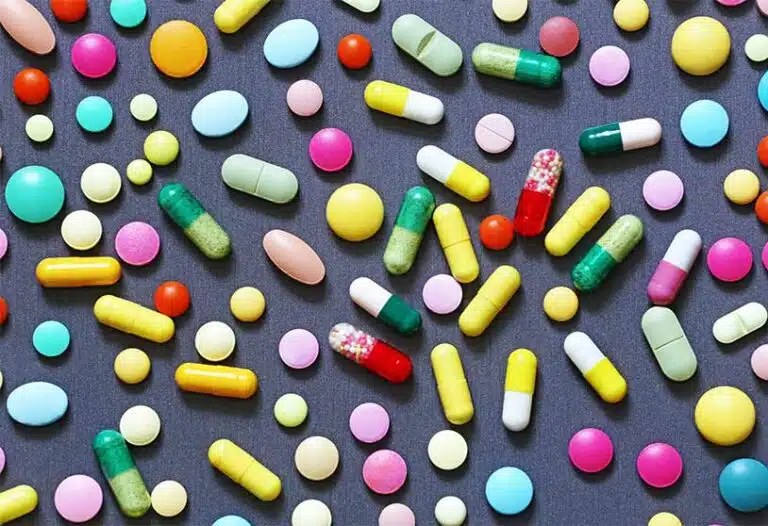The Top 10 Most Dangerous Synthetic Drugs
- Fentanyl
- Carfentanil
- Pink
- Gray Death
- Synthetic Cathinones
- Synthetic Cannabinoids
- Synthetic Hallucinogens
- Krokodil
- Novel Benzodiazepines
- Ecstasy

Over the past few years, synthetic drugs have surged in popularity. These man-made substances contain a variety of unnatural ingredients that can wreak havoc on your body. While all synthetic drugs pose health risks, some are more dangerous than others.
1. Fentanyl
Fentanyl is a prescription opioid used to treat severe pain, usually from surgery or late-stage cancer. According to the Centers for Disease Control and Prevention (CDC), it’s up to 50 times stronger than heroin.
Even a tiny dose can slow your breathing to the point of death. It’s also highly addictive.
Some people illegally manufacture fentanyl and sell it on the street. This type of fentanyl is the main driver of the nation’s overdose crisis.
2. Carfentanil
Carfentanil is a synthetic opioid that’s chemically similar to fentanyl. Veterinarians use it as an anesthetic for elephants and other large animals.
Unlike fentanyl, carfentanil is not approved for human consumption.That’s because it’s 100 times stronger than fentanyl and 10,000 times stronger than morphine.
In other words, it poses an extremely high risk of addiction and overdose. Even so, some people buy carfentanil on the street and abuse it.
3. Pink
Pink is the street name for a synthetic opioid called U-47700. It was developed in the 1970s as an alternative to morphine. However, it was never approved for medical use. Today, some people buy the drug online or on the street.
Like other synthetic opioids, pink often causes addiction and overdose. While it’s not as strong as fentanyl and carfentanil, it’s about 7.5 times stronger than morphine.
4. Gray Death
The term “gray death” refers to a dangerous mixture of illicit drugs. This mixture typically includes U-47700, fentanyl, and heroin. Some types of gray death also include other synthetic drugs as well as cocaine or amphetamines.
In general, gray death resembles gray concrete, hence the name. It can be injected, snorted, or smoked. Some people also press it into a tablet to swallow. All forms of gray death pose an extremely high risk of addiction and overdose.
5. Synthetic Cathinones
Often called designer drugs or “bath salts,” synthetic cathinones are chemically similar to cathinone, a substance found in the khat plant. People who use synthetic cathinones face serious health risks, including:
- panic attacks
- paranoia (irrational distrust of others)
- hallucinations (seeing, hearing, or feeling things that aren’t there)
- extreme irritability
- violent behavior
- increased heart rate and blood pressure
- chest pain
- kidney failure
- death
You can also become addicted to synthetic cathinones. If you stop using them, you may experience withdrawal symptoms such as depression, anxiety, and insomnia (trouble sleeping).
6. Synthetic Cannabinoids
Synthetic cannabinoids are especially popular among young people. They are designed to mimic the effects of THC, the main psychoactive ingredient in cannabis (marijuana). They have various street names, including K2, Spice, and Black Mamba. Possible side effects include:
- anxiety
- psychosis (a loss of connection with reality that often involves paranoia, hallucinations, and delusions)
- suicidal thoughts
- nausea and vomiting
- kidney problems
- seizures
- stroke
- death
7. Synthetic Hallucinogens
As the name suggests, synthetic hallucinogens are designed to mimic traditional hallucinogens such as LSD and magic mushrooms. They’re often called N-bombs. Like traditional hallucinogens, they can have serious side effects, including:
- rapid heartbeat
- nausea and vomiting
- mood swings
- anxiety
- panic
- a sense of detachment from your body
- hallucinations
- paranoia
- psychosis
Some people also experience flashbacks to certain effects, especially hallucinations. These flashbacks may last for days, months, or even years after you use synthetic hallucinogens.
8. Krokodil
Krokodil is the street name for desomorphine, a drug made from an opioid called codeine. It tends to include toxic additives such as paint thinner, hydrochloric acid, and gasoline.
People who use this drug may develop scaly green skin reminiscent of a crocodile (hence the name “krokodil,” the Russian word for crocodile).
Other effects of krokodil may include:
- bone, muscle, liver, or brain damage
- kidney failure
- pneumonia
- overdose
- death
9. Novel Benzodiazepines
Novel benzodiazepines are substances that chemically resemble traditional benzodiazepines, such as Xanax and Valium. Like these medications, novel benzodiazepines may ease anxiety, insomnia, and seizures.
However, they can also have negative effects such as muscle weakness, memory problems, and physical dependence.
Also, unlike regular benzodiazepines, novel benzodiazepines are not regulated by the Food and Drug Administration (FDA). That means they may have additional short-term and long-term effects that researchers have not yet discovered.
10. Ecstasy
Also known as MDMA or molly, ecstasy is a synthetic drug with hallucinogenic and stimulant effects. It first became popular at nightclubs and raves. The drug’s most common side effects include nausea, sweating, and blurry vision.
At high doses, ecstasy can also cause a dangerous spike in body temperature. This spike may lead to failure of the liver, kidney, or heart. These failures can be deadly.
If you or a loved one struggles with synthetic drug use, please reach out to an Ark Behavioral Health specialist. Our board-certified healthcare providers offer medical detox, mental health counseling, and other personalized treatments to help you stay drug-free.
Written by Ark Behavioral Health Editorial Team
©2024 Ark National Holdings, LLC. | All Rights Reserved.
This page does not provide medical advice.
Attorney General of Texas - Synthetic Drugs
Cureus - U-47700: An Emerging Threat
Drug Enforcement Administration - Carfentanil: A Dangerous New Factor in the U.S. Opioid Crisis
Drug Enforcement Administration - Spice/ K2, Synthetic Marijuana
National Institute on Drug Abuse - Hallucinogens
National Institute on Drug Abuse - MDMA (Ecstasy/Molly) DrugFacts
National Institute on Drug Abuse - Synthetic Cathinones ("Bath Salts") DrugFacts
Neurology International - Novel Designer Benzodiazepines: Comprehensive Review of Evolving Clinical and Adverse Effects

Questions About Treatment?
Ark Behavioral Health offers 100% confidential substance abuse assessment and treatment placement tailored to your individual needs. Achieve long-term recovery.
100% confidential. We respect your privacy.
Prefer Texting?
Our friendly support team is here to chat 24/7. Opt out any time.







 Learn More
Learn More








